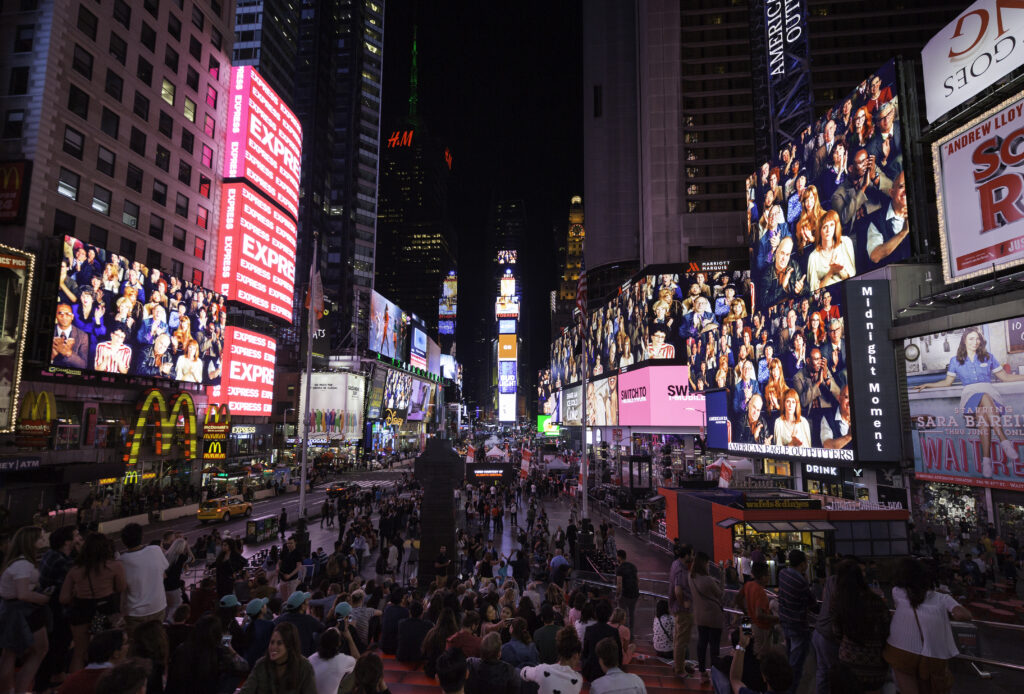Toronto’s digital billboard-laden Yonge and Dundas Square is owned by the city but managed through a public-private partnership. While primarily hosting commercial content and activities, the spaces and screens of the square are often used for cultural events and artistic content. As cities, arts organizations, governments, and corporations increasingly seek to engage people in public spaces through combinations of media and architecture, what are some of the possibilities and pitfalls associated with their approaches individually and in concert with one another? How does media architecture modulate civic, creative, and commercial interests and impacts?
From my perspective as founder of Midnight Moment; Chair of Urban Arts Forum of Urban Land Institute UK; and an international cultural advisor, global commercial property market and local authorities have embraced the value of innovative digital media on architecture. But that hasn’t always been the case; it is a result of almost 50 years of artistic intervention.
The first digital interventions of artist work contrasted the commercial advertising. The exception to the rule was a subversive act that countered the commercialisation of architecture and attracted curiosity and attention from text and/or visuals that countered the vernacular of commercial consumption. As the technology became more digitally sophisticated, there was a second wave of intervention that leveraged a moving image platform to generate content that was equivalent to the duration of music videos or other entertainment formats. From Creative Time’s platform ‘The 59th minute’ & MTV 44 ½ (single channel screens in Times Square) to the light & fountain show of Dubai’s Burj Khalifa, the programmed anomaly uses its occasional, special presentations as a means to gather people in places-with the permissions and interest of the property holders.
Now, architects regularly create spaces for digital content and audiences are trained to look for unusual content. Sometimes the media architecture is built for art display that is then subsidised by the advertising; flipping the original ratio of commerce/culture. Outdoor advertising takeovers such as Midnight Moment (NYC) and CIRCA (London, Seoul, Tokyo) are becoming ‘institutions.’ Digital art is part of every international artfair or festival. Drones have become a curation of the sky – forming temporary architectures as part of concerts and civic events.
As new squares and buildings use art to compete to have its own brand identity, it is necessary to interrogate what is the correct balance of programming, the duration of digital media in permanent architecture, and the realities of ongoing expense and consumer/audience fatigue.

I propose that public art has three-tiers of success, which can flex between criteria for curation or measurements for success:
- Aesthetically Engaging – passers-by engage with the work (without additional interpretation)
- Contributes to an Art Historical/ Historic discourse – the artist or artistic style brings a culturally-trained audience
- Contributes to a current Public/Civic Dialogue – the subject matter engages important, timely occasions, celebrations, scholars, social debates

This critical framework brings the cultural, commercial and civic sectors together in a confident curation/selection process. It is a tool to acquire more knowledge of the artist and artwork and query the choices that are appropriate to place and to openly test the digital gallery’s function or a specific work’s interpretation against diverse perspectives (representative of their audiences). It can inform the exhibition presentation and mitigate risk (and fear) at the forefront, leaving room to explore nuance of presentation-whether the style or message demands short and frequent showing; immediacy and saturation/domination; special (exclusive) showing; or semi-permanent presence. The resulting respectful, cross-sector dialogue additionally generates a shared trust that empowers greater collective ambassadorship, funding and risk-taking. For more on this, see the recording of my keynote from MAB23.
The immediacy of the medium enables cities or companies to be dynamic and supportive of the fast-shifting discussions of contested histories, inclusive representation and liberation from static monuments or safety of geometrically abstract public art. With skilled care, purpose and sophisticated employment of the media, our public digital media ‘galleries’ can be riskier, critical catalysts for gathering communities for civic conversations and celebrations.
Without critical mindfulness, media architecture is in danger of being just an expensive glitch.
The Media Architecture Biennale 2023 (MAB23) took place June 14-15 (online) and June 21-23 (in-person) in Toronto, Canada. The event featured keynotes, roundtables, and awards, creating a platform for communities of research and practice concerned with media and the built environment. MAB23 brought together students, academics, and professionals from architecture, art, design, urban planning, media and communication, urban informatics, and public policy to share new ideas and shape this evolving field.
One of the themes for MAB23 was Civic/Creative/Commerce.
To learn more about the Media Architecture Biennale, and to see the nominees and winners for this year’s awards, visit mab23.org
As new squares and buildings use art to compete to have its own brand identity, it is necessary to interrogate what is the correct balance of programming, the duration of digital media in permanent architecture, and the realities of ongoing expense and consumer/audience fatigue.
Sherry Dobbin
